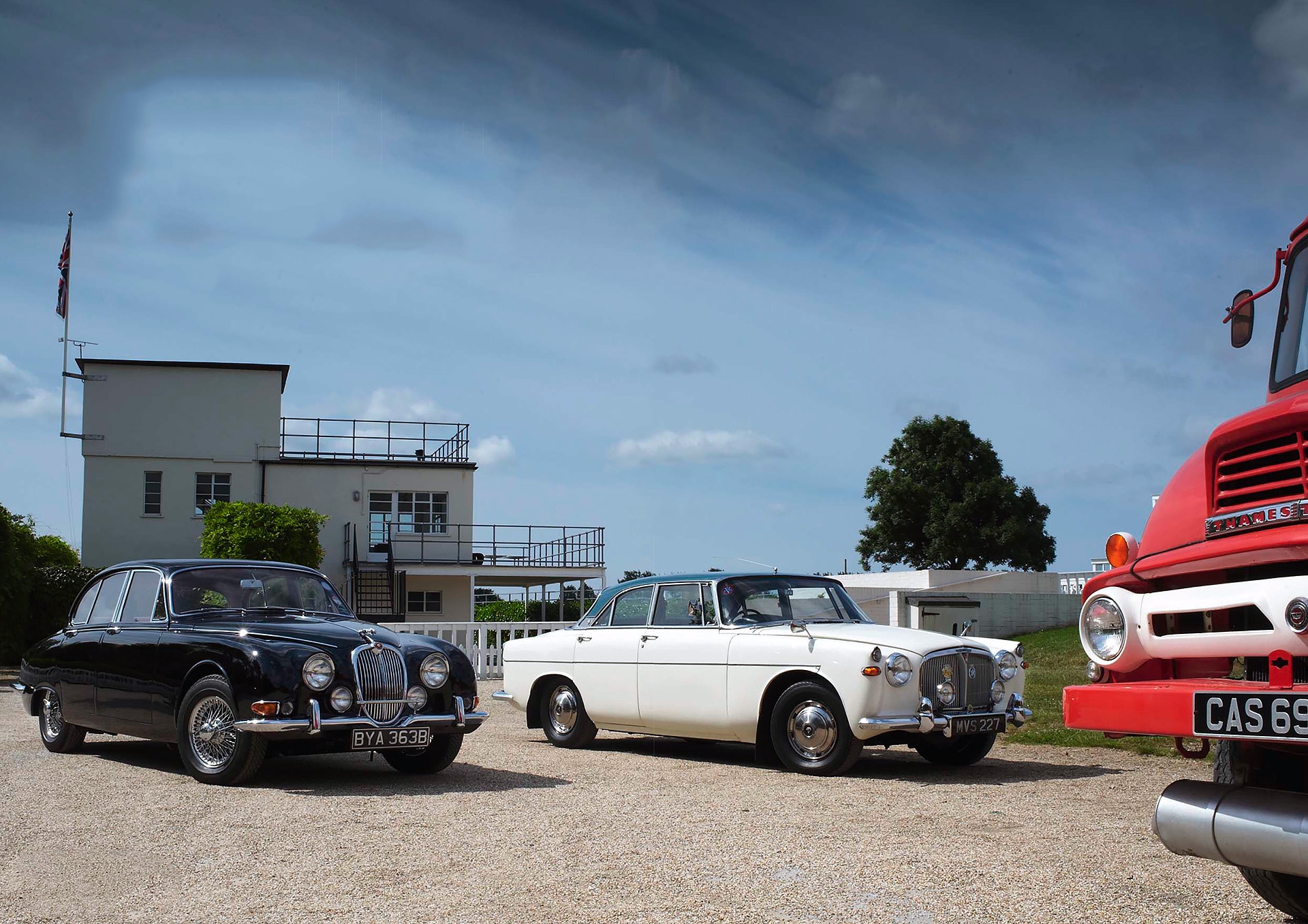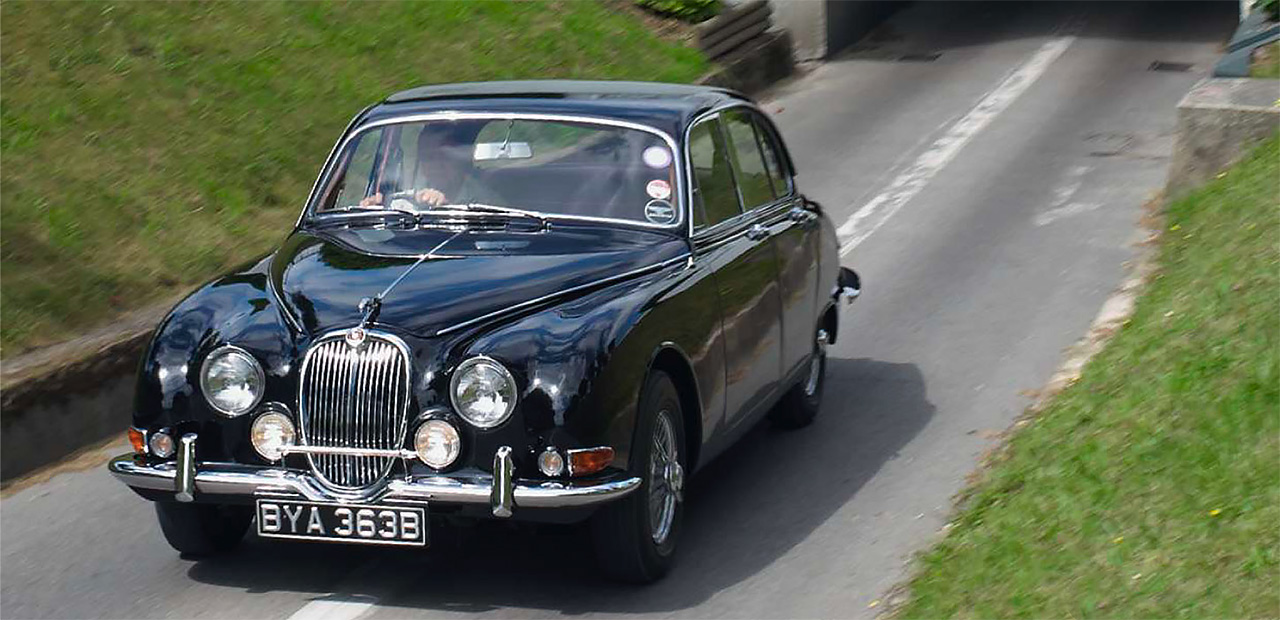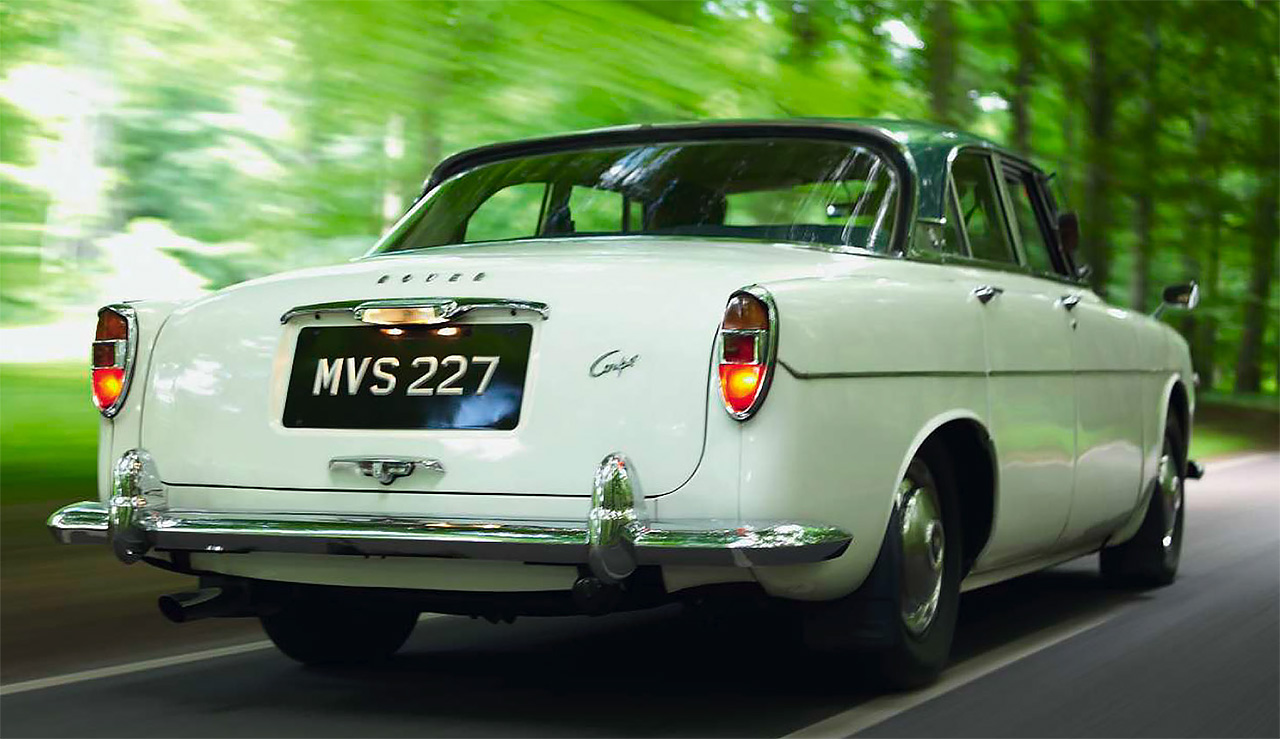
Gentleman’s carriages – Jaguar versus Rover. We pitch a Jaguar S-type against a Rover P5 Coupe in this Sixties executive express face-off. Racing’s finished for the day, so which will do the better job of whisking you back from Goodwood to your stately pile: Jaguar S-type 3.4 or Rover P5 Coupe? Words Paul Stassino. Photography Gus Gregory.
Day at the races in 1964: pork pie, strong mustard and watching Mini Coopers battle Ford Falcons. Question is, what transport do you favour to whisk you back to your pile in the country in true sporting fashion – the new Jaguar S-type or Rover’s P5 3.0-litre Coupe? Our journey takes us 16 miles from the Goodwood Paddock to Stansted House in Hampshire in the style of well-heeled motorists five decades ago, re-creating the last days of oblong road signs and black-and-white striped traffic light poles.

Of our pair the black 1964 S-type looks like every schoolboy’s idea of a performance car. When MkX debuted in late 1961 it left a marketing gulf between itself and the compact Mk2, so the S-type was developed in just two years to bridge the gap. Browns Lane initially intended the new car to be the Mk2’s successor, but just before the S-type’s launch in October 1963 Sir William Lyons decided the Mk2 would remain in production. The 3.8S was joined by a 3.4-litre model in early 1964, and the S-type stayed in production until the XJ6 replaced it in 1968.

Back in the autumn of 1963 the S-type’s appearance was almost as controversial as The Beatles starring in The Royal Variety Performance, because many Jaguar enthusiasts thought it fell short of the standards set by the Mk2 and MkX. The flattened roofline, devised to improve headroom for rear passengers, is the S-type’s least successful aspect, but the frontal treatment with its hooded headlamps works extremely well. The cabin is much the same as the Mk2, with only a few modifications – the rear picnic tables disappeared but an under-dashboard map tray was introduced, and a split bench replaced the front bucket seats. In theory the combination of adjustable steering and reclining backrests should make a 3.4S a more comfortable place than its cheaper stablemate, but the seating offers no lateral support other than the folding armrests.

Independent rear suspension brought new refinement to the Mk2 family. S-type unites Mk2 front end with MkX rear.
However, the prospect of sliding across the seat is a minor issue when you experience the thrill of pressing the starter button to unleash the sweet music of the XK straight-six. Some Jaguar owners prefer the later V12 or 4.2-litre XK, but for me there is nothing to beat the magical sound of a 3.4-litre in fine tune. All in-period S-type road tests featured the 3.8S, which was also the most commercially popular of the two models, yet the free-revving 3.4 engine seems so well suited to the S-type. Our test car is especially rare in having a Moss gearbox; post-October 1964 cars had an all-synchromesh Jaguar-built unit.
Joining the A285, I discover that rushing the Moss box is never a good idea. The clutch is heavy and my attempts to zoom through the gears makes the Jaguar behave with the stubbornness of a mule on work-to-rule, which means I have to engage the ancient art of double-declutching.
I grasp the stout lever firmly and make slow but steady changes. Gently changing up from first to second has the S-type leaping forward like a bank robber fleeing DI Reagan in The Sweeney, though without the TV series’ squealing tyres.
Variomatic power-assisted steering was an S-type option, but it’s not fitted to this example. Crawling through T-junctions in built-up areas may develop character and upper arm muscles, but once on the open road the 3.4S has feel and poise without much of the heaviness associated with big British cars of this era. The steering is quite low-geared, but only a small amount of movement is needed to leave a Z-bend with absolute assurance, and the S-type behaves neutrally even with the throttle applied on a medium curve – and I rarely need those folding armrests to anchor me in place on a sharp right bend.
The S-type weighs around 150kg more than the Mk2, yet doesn’t feel as if it’s acquired any middle-age spread; there’s a supple grace to the way in which it moves through Emsworth. The greater weight is largely down to the independent rear suspension used in MkX, which gives a surprisingly soft ride without sacrificing any handling ability. Serenely crossing the pock-marked surfaces of these typical Hampshire B-roads without transmitting any discomfort to the occupants, this 3.4S is proof that a sports saloon doesn’t have to sacrifice an iota of driver comfort.
‘The S-type weighs 150kg more than the Mk2, yet doesn’t feel as if it’s acquired any middle-age spread’
As for the brakes, what was regarded as ‘light and progressive’ in the early Sixties translates today as ‘requiring a considerable amount of size-12 brogue to operate’. Overall this Jaguar is best regarded as a delightful paradox. In its heyday it was referred to by motoring snobs as ‘nouveau’ and favoured by trend-setters like Tom Jones and Simon Dee, yet for me conveys a distinct air of traditionalism. On this journey the lush greenery of Sussex has been framed by solidly thick windscreen pillars and the un-ergonomic piano key switches mean the unwary risk confusing the starter button with the cigar lighter. These details were anachronistic by the standards of five decades ago, but today they are essential aspects of the S-type’s charm.
For motoring home from the Goodwood paddock the Jaguar only has one serious rival: the P5 Coupe. Rover’s styling genius David Bache simultaneously designed a coupe version of the P5 along with the standard model, but limited resources meant it wasn’t launched until 1962, four years after the saloon. Mechanical parts were common to both cars and like all post-autumn 1962 P5s our 1963 example has a Weslake-designed cylinder head that gives it a top speed in excess of the magic 100mph.
The 3.0-litre P5s were replaced in late 1967 by the 3.5-litre P5B and I am surely not alone in preferring the understated appearance of the P5 to the aggressive looking P5B with its additional chrome and flamboyant rostyle wheels. But wrhile the 3.0-litre saloon is merely handsome in the metal, the Coupe is truly stunning. Its proportions are perfect and the slim windscreen pillars give it a decidedly sporting look.
I settle into the P5’s front armchair (this is no mere seat), adjusting the backrest and turning a handle to alter the height of the seat cushion. There’s a surfeit of charming touches: a combined tool tray/picnic table emerges from beneath the front parcel shelf, the fuel gauge doubles as an oil level indicator and you can position the armrests on the front doors for maximum comfort.

I turn the key and the P5 discreetly rumbles into life. While I can imagine a 1964 Jaguar driver impatiently waiting for a green traffic light, eager to show Hillman Minx owners the prowess of a true sports saloon, a P5 owner would feel no such urge. In fact it is the manner of leaving the lights that marks an essential difference between Jaguar and Rover as there’s little to choose from in their respective 0-60mph times. The S-type wants to accelerate away with a sense of drama; but if your idea of a sporting saloon involves a vibrant engine note and wearing a Terry Thomas-style cheese-cutter cap, then the Rover is not the car for you. It makes a virtue of being noticed but rarely heard, and instead of groping my way round the S-type’s vintage-style gearbox, getting the best from the Coupe on a straight run merely requires moving the lever with the minimum of effort and the maximum of grace.
Rover fitted the Coupe with Hydrosteer power steering as standard and although it offers less feel than the S-type it lacks the disconcerting weightless sensation of contemporary big British saloons such as the Vanden Plas Princess R. It also makes the Rover a more suitable town car than the Jaguar, but it is on trunk roads that the Rover really shows its mettle. The ride is less soft than the S-type’s, but the straight-six is incredibly smooth and the thick upholstery helps to insulate you. The Coupe’s dashboard boasts a tachometer – an essential fitting as the inlet-over-exhaust straight six is so refined you need to ensure you’re not over-revving it. Cross-winds fail to disturb the Rover’s progress and its occupants are so insulated from road noise that whooshing along the A27 all you hear is the ticking of the clock.
Away from the main drag, South Downs B-road potholes bounce the Rover’s occupants around and seemingly gentle corners generate a large amount of roll. Such revelations make the P5’s venerable rear leaf-spring suspension very obvious. Compared with the Jaguar the Rover lurches in a most undignified fashion, and a further impediment to exuberant driving is the braking system: press the pedal, wait, then press again with more urgency is the order of the day. However, the budding P5 aficionado soon learns that on approaching a curve near the wilds of Rowlands Castle in Hampshire, braking early and then accelerating through proves much less unseemly.
The standard of interior trim is of paramount importance in both cars; prospective owners needed to be reassured that while National Service may have ended and hat-wearing was on the wane, all was still utterly correct inside a Jaguar or Rover. The S-type’s detailing is exquisite, from the door pockets to the wool headlining, but if the P5 were coachbuilt it could not have been a better machine. In place of the Jaguar’s wardroom atmosphere the Rover offers a distinctly Sixties interpretation of solid British traditionalism: the dashboard is finished in discreet cherry timber rather than walnut and the instrument layout shows more of an attempt at ergonomics. Piloting these cars through West Sussex and Hampshire on a very hot day reminds me of the Jaguar’s primitive ventilation system – it would not be until 1968 that the company moved into the modern era with the XJ6’s eyeball air outlets – and made me appreciate all the more the Rover’s jet-style vents.
Both cars finally sweep majestically into the driveway. This has been more than a story of Old Money versus New Money – it’s more a demonstration of how two cars made by manufacturers at the height of their powers can continue to surprise. The S-type combines the best elements of Mk2 and MkX, bringing the ethos of the pre-war sportsman’s transport to the era of the Beatles. It reminds the most jaded of motorists of the joys of driving – and how many other 50-year-old cars would you happily consider using on a long journey?
‘For the owner who likes to give the chauffeur two guineas to take the night off, the P5 is a gem’
Meanwhile, for the owner who may not require a sports saloon but still likes to give the chauffeur two guineas to take the night off, the P5 is a gem. It’s not the equal of the Jaguar as a performance car, but as a four-door coupe with understated good looks and standards of comfort and refinement approaching those of a Rolls- Royce Silver Cloud it truly is unique.
Thanks to the owners, Jaguar Enthusiasts’ Club (jec.org.uk), Rover P5 Club (roverp5club.org.uk), Goodwood (goodwood.co.uk), Stansted House (stanstedpark.co.uk)
THE OWNER
Rover: In 1997 Paul Witcombe was searching for a classic car that had so impressed him as a young driver. ‘I thought I had absolutely no chance of finding a white Rover P5 3.0-litre with manual/overdrive transmission and coupe body, but I was incredibly lucky.’ He finds the car eminently usable. ‘It’s very comfortable and the 3.0-litre engine means it’s more than capable of keeping up with today’s traffic. ’Witcombe says the Rover’s Achilles heel is its steering box. ‘They are known to leak oil, ‘he says, adding, ‘Mechanically it’s quite a simple car and shouldn’t ever let you down as long as you use intelligence in day-to-day maintenance.’
THE OWNER
Jaguar: It’s the rear suspension that really makes the S-type,’ reckons John Tatar. ‘Compared with my Daimler 2.5-litre V8 saloon, the S is not just a better handling car, it’s more sporting too.’ Tatar has owned his Jaguar for seven years and says it ‘simply begs to be driven enthusiastically’. He adds, ‘Once you’ve become acquainted with the Moss gearbox and learned not to rush it, it’s a truly delightful car.’ The absence of in-period road tests of the 3.4 means ‘the S-type fitted with this engine is an overlooked gem of Jaguar’s line-up’, says Tatar. His car had a full body restoration in 2000 and was a big attraction on the Jaguar Enthusiasts’ Club stand at the 2013 NEC Classic Motor Show. Tatar drives it regularly and his main expense is consumer durables such as oil filters. He cautions that finding spares can be a challenge. ‘Make sure the parts you buy are of reputable quality otherwise the car will suffer.’
| 1964 JAGUAR S-TYPE 3.4S | 1963 ROVER P5 COUPE Mkll |
|
Engine 3442cc, in-line six-cylinder, dohc, two SU HD6 carburettors Power and torque 210bhp @ 5500rpm; 216lb ft @ 3000rpm Transmission Four-speed manual with overdrive, rear-wheel drive Steering Recirculating ball Suspension Front: independent, double wishbones, coil springs, telescopic dampers, anti-roll bar. Rear: independent, lower wishbone, driveshaft as upper link, radius arms, twin coil springs, telescopic dampers Brakes Discs front and rear Weight 1560kg (3440lb) Performance Top speed: 115mph; 0-60mph: 13.9sec Fuel consumption 18mpg Price new £1840 Value now £25,000 |
Engine 2995cc. in-line six-cylinder, ioe, one SU HD8 carburettor Power and torque 129bhp @ 4750rpm; 161lb ft @ 3000rpm Transmission Four-speed manual with overdrive, rear-wheel drive Steering Recirculating ball Suspension Front: independent, double wishbones, torsion bars, anti-roll bar. Rear: live axle, semi- elliptic springs, telescopic dampers Brakes Discs front, drums rear Weight 1651kg (3640lb) Performance Top speed: 107 mph: 0-60mph: 15sec Fuel consumption 17mpg Price new £1750 Value now £8000 |





